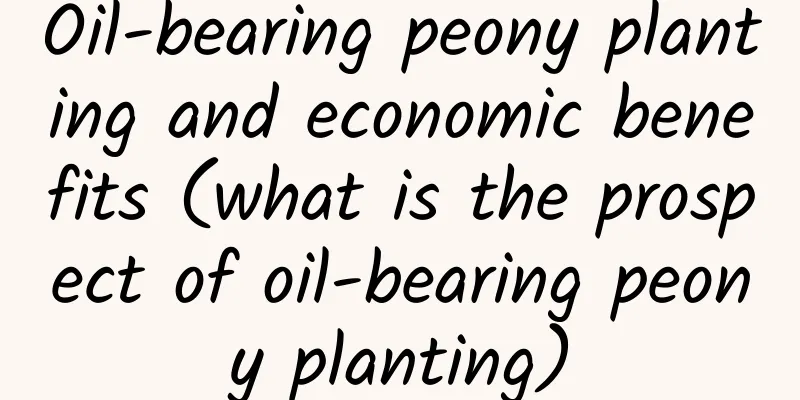Oil-bearing peony planting and economic benefits (what is the prospect of oil-bearing peony planting)

Prospects of Oil Peony PlantingIn recent years, oil-bearing peony has become popular. It is a new high-quality woody oil crop. It only needs to be planted once and benefits from it in the following years. Peony has been promoted nationwide, especially in mountainous and hilly areas where it has a prominent role. Oil-producing peony has the characteristics of three highs and one low, mainly: high yield, high oil content, high quality, and low cost . It can be planted in arid and barren areas, and is more suitable for greening barren hills and intercropping in woodlands. In recent years, many regions in the country have begun to develop the oil peony industry, and its cultivation prospects have been promising. In particular, in 2011, peony seed oil was identified as a new resource product and became an important component of edible oil after approval by the expert committee. Its emergence is of great significance and will inevitably affect the consumption structure of edible oil in my country. At present, China strongly encourages the strengthening of research on peony seed oil. The development of the oil peony industry will inevitably affect the current situation of large-scale import of edible oil in China. The future of oil peony has broad prospects. Not only can oil be extracted, but the whole body is a treasure. The benefits of growing oil-bearing peonyPlanting peony has high economic benefits. Compared with other oil crops, oil-bearing peony has high oil yield (oil content over 22%) and high quality oil. Oil-bearing peonies begin to produce seeds from the third year, and their seed-producing lifespan can reach over 60 years. During the peak production period, the seed yield per mu is about 400 kilograms. Based on the purchase price of 20 yuan per kilogram in 2012, the annual income per mu can reach about 8,000 yuan. Based on the 30-year production cycle of peony, the net income per mu is more than 6,000 yuan ; based on the annual benefit of 1,200 yuan per mu for planting conventional crops, the benefit of planting oil-bearing peonies is about 5 times that . How to plant oil-bearing peony to get high yield and better benefits1. Planting timeRegarding the planting time of peony, there is a saying among the people that "if you plant a peony in spring, it will never bloom" and "Seventh month of Chinese peonies, August of peonies". This means that it is generally not easy for peonies to bloom in spring, and only those planted in autumn will bloom normally. The main reason for this is that peonies like coolness, and autumn is the peak season for their root growth. As a large amount of nutrients continue to accumulate in the roots, the root buds begin to enter the active germination period. This is not only conducive to the recovery of injured roots, but also conducive to the growth of new roots. Therefore, people often choose to plant peonies in autumn. 2. Planting plotsOil peony is tolerant to barrenness, cold, drought and shade. Therefore, it can grow even on slopes, tidal flats and ridges. However, it prefers rich and loose soil and a cool and ventilated environment with sufficient light. Therefore, when planting, it is best to choose a plot with open terrain, fertile soil and not prone to waterlogging. It is also best to intercrop with other economic trees to meet its growth habits of liking coolness and avoiding strong light. 3. Seedling treatmentThe propagation of oil-bearing peony is usually divided into division propagation and sowing propagation. As an oil-bearing economic crop that "plants once and benefits for many years", it is generally planted on a large scale. Therefore, people usually choose to plant seedlings. When planting, it is advisable to choose 2-3 year old healthy seedlings, first disinfect and sterilize their rhizomes and seedlings; then soak them in rooting water for 2-3 hours, and then dig holes and plant them to help increase the survival rate. 4. Planting densityOil peony is generally a dwarf shrub with a height of about 2 meters and a strong branching ability. Therefore, when planting, the density should not be too large to ensure that the plant has a large growth space and is conducive to lighting and ventilation. When planting, you can reasonably determine the planting density based on the variety's growth ability and personal planting experience. 5. Water and fertilizerWhen it comes to the application of water and fertilizer to oil-bearing peonies, people often decide on the application of water and fertilizer based on the proverb "spring branches, summer naps, autumn roots, winter dormancy". There is a reason for this. Spring is the peak season for the growth of branches and leaves of oil peony, so the demand for water and fertilizer is naturally greater. You can follow the methods of "no watering unless the soil is dry" and "apply thin fertilizer frequently" to decide on watering and fertilizing. In summer, because peonies are afraid of high temperatures, they are almost in a semi-dormant state of "drowsiness". Therefore, the consumption of water and nutrients is much less than in spring. Therefore, it is advisable to water and fertilize less. Autumn is the season when peonies start to grow rhizomes, so it seems that they need frequent watering and fertilization. In fact, this is not the case, because in autumn, the peony seeds are all harvested, the leaves fall and the branches wither, the nutrients tend to concentrate at the roots, and because of the low temperature, there is no large water consumption. Therefore, it is advisable to water less and apply less or no fertilizer during this period. In winter, the oil peony completely enters a hibernation period and is in a "no eating, no drinking" state, so watering and fertilizing should be stopped. 6. Weeding and loosening the soilOil-producing peony is an economic crop that is planted once and harvested for many years. Every spring and summer, when the plants are growing vigorously, weeds will also grow vigorously. Therefore, loosening the soil and weeding are necessary. Otherwise, too many weeds will not only affect lighting and ventilation, but also compete for water and fertilizer, affecting seed quality. 7. Disease and pest preventionOil-bearing peonies have strong resistance to diseases and insects, but the possibility of bacteria breeding and insect attacks due to climatic reasons or failure to meet lighting and ventilation requirements cannot be ruled out. Therefore, during the peak growth season in spring and summer, it is advisable to pay close attention to its growth and eliminate potential disease-causing hazards in a timely manner, such as timely removal of diseased leaves, timely thinning, timely water and water drainage, and timely spraying of disease and insect repellent liquids. 8. PruningOil peony is a deciduous shrub with strong branching ability. Therefore, it is advisable to do necessary pruning and cleaning after winter. First, cut off the weak and dead branches; then cut off the densely growing and overlapping branches; finally, cut off the overgrown branches and add simple shaping. |
<<: Tips for Pruning Plums in Winter (Plum Tree Pruning Methods and Techniques in Winter)
>>: Why do we need to clean the orchard in winter (how to clean the orchard after picking the fruit)
Recommend
When does the osmanthus fragrans sprout and grow leaves?
Overview of Murraya paniculata The origin of Osma...
Is Kochia scoparia suitable for indoor potted plants?
1. Is it suitable? Kochia scoparia is suitable fo...
How to plant Hypericum in pots
1. How to pot plants: When planting a potted Hype...
Planting and cultivation methods of lily bulbs
The most suitable temperature for lily growth is ...
How to trim the Jasper
When to trim the Jasper It is best to prune the J...
Reasons and solutions for freesia not blooming
Freesia, also known as freesia, is a typical autu...
Cultivation methods and precautions of rock peony
How to grow rock peony Pot soil selection Rock pe...
Can grapefruit trees be potted?
Can grapefruit trees be potted? The pomelo tree c...
Should Bird of Paradise be watered thoroughly? The correct way to water
Is the bird of paradise watered thoroughly? The b...
How to grow dragon fruit
1. Seed processing Choose a ripe dragon fruit, pe...
How to trim the pompom porch
Pom Pom Porch Mowing Time Generally, after the fl...
How many times a year can tomatoes be planted? Can they be planted all year round?
How many seasons can tomatoes be grown in a year?...
What to do if black spots appear on Anthurium leaves
1. Improper moisture If black spots appear on the...
How long does it take for a sunflower to bloom after it is planted? How long does it take for a potted sunflower to bloom after it germinates?
Sunflowers grow relatively fast and will bloom in...
When does silver jasmine bloom?
1. Flowering time The flowering period of silver ...









